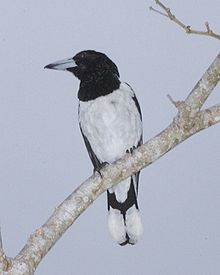- Hooded Butcherbird
-
Hooded Butcherbird 
Photo taken in Biak, Papua Conservation status Scientific classification Kingdom: Animalia Phylum: Chordata Class: Aves Order: Passeriformes Family: Cracticidae Genus: Cracticus Species: C. cassicus Binomial name Cracticus cassicus
(Boddaert, 1783)The Hooded Butcherbird (Cracticus cassicus) is a species of passerine bird in the Cracticidae family. It is found in Indonesia and Papua New Guinea. Its natural habitat is subtropical or tropical moist lowland forests.
Contents
Taxonomy
The Hooded Butcherbird was first described by Dutch naturalist Pieter Boddaert in 1783, its specific epithet cassicus derived from the Latin "wearing a helmet" or "hood". It is one of six (or seven) members of the genus Cracticus known as butcherbirds. Two subspecies are recognised; The nominate race cassicus is found on mainland New Guinea and islands to the west, as well as Kairiru, Mushu and Basilaki Islands, while the larger race hercules occurs on the D'entrecasteaux Archipelago and Trobriand Islands.[1]
A local name in Ketengban is moro-moro.[2]
Description
Measuring 32–35 cm in length, the male and female are similar in appearance. The plumage is predominantly black and white, the bird bearing a black head, nape and throat, white underparts, rump, and back, and black and white mantle. The tail is black, with a broad white tip. The robust pale bluish-grey bill is hooked and tipped black. The iris is black or dark brown, and the legs and feet are dark grey to black. It can be distinguished from the Black-backed Butcherbird by its black throat.[1]
The Hooded Butcherbird has a complex fluting song, made up of many varied components. Birds may duet with each other, or mimic other species such as the Rusty Pitohui, Little Shrike-thrush, Spangled Drongo, or Helmeted Friarbird.[1]
Distribution and habitat
Found on New Guinea and surrounding islands, the Hooded Butcherbird inhabits forested country mainly in lowland areas to elevations of 650 m, or occasionally 1450 m. It is fairly common and may also be found close to human habitation in coconut groves.[1]
Behaviour
It is carnivorous. Birds are found in pairs or small family groups.
Records indicate breeding may occur at any time.[3] Located on a branch 8.5–25 m above ground, the nest is a bowl constructed of twigs and sticks. Two or three pale olive-brown or -green eggs are laid, blotched darker brown and measuring 31.8-35.6 x 23.7-25.6 mm.[1]
Footnotes
- ^ a b c d e Coates, Brian J. (1990). The Birds of Papua New Guinea, Including the Bismarck Archipelago and Bougainville. Vol. 2: Passerines. Alderley, Qld.: Dove. pp. 368. ISBN 978-0959025712.
- ^ Diamond, Jared; Bishop, K. David (1999). "Ethno-ornithology of the Ketangban People, Indonesian New Guinea". In Medin, Douglas L., Atran, Scott. Folkbiology. MIT Press. pp. 28. ISBN 026263192X.
- ^ Coates, p. 369
References
- BirdLife International 2004. Cracticus cassicus. 2006 IUCN Red List of Threatened Species. Downloaded on 25 July 2007.
Categories:- IUCN Red List least concern species
- Cracticus
Wikimedia Foundation. 2010.

